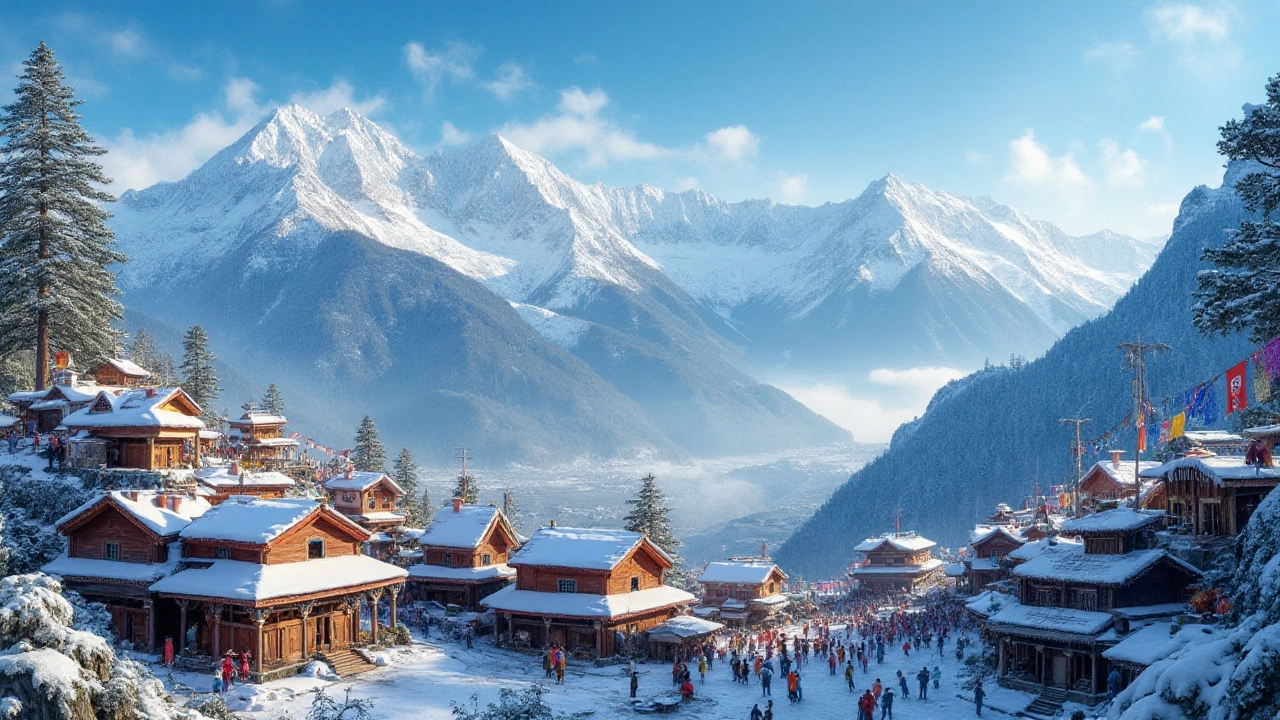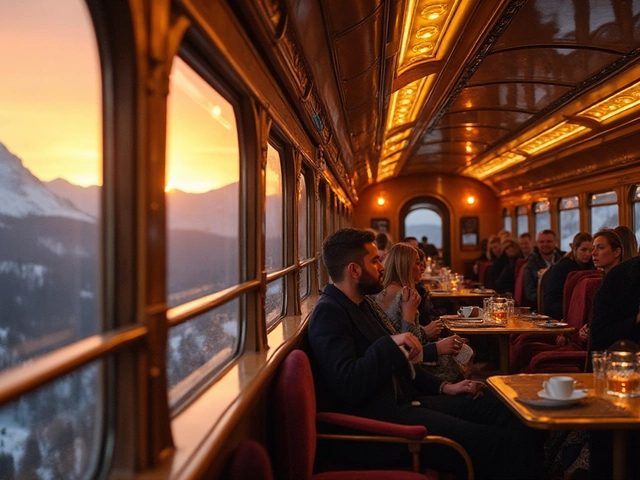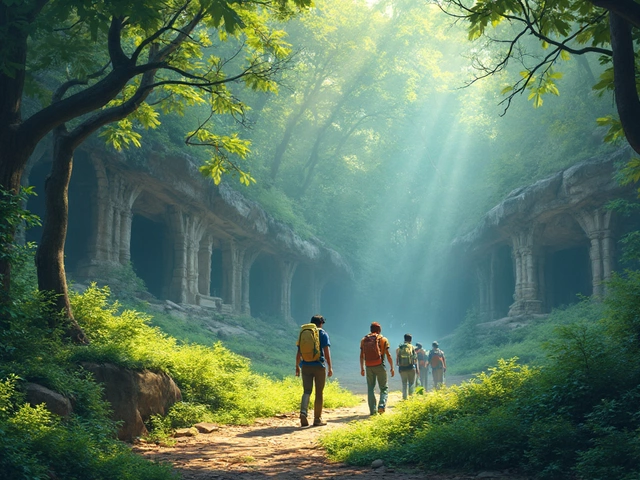Northern India presents a fascinating blend of landscapes, climates, and cultures, each adding a unique layer to the region's enticing charm. During the winter months, this diverse region can indeed get quite cold, offering both locals and travelers a refreshing briskness in the air. From the snow-draped peaks of the Himalayas to the misty mornings of the plains, Northern India's winter is a time of beauty and exploration.
This season transforms iconic destinations, enhancing the experience with a touch of chill and wonder, while the climate varies considerably across locations. Whether you're drawn to the thrill of mountain adventures or the coziness of cultural festivities, Northern India's winter holds something for everyone. Pack your warm clothes and immerse yourself in the extraordinary tapestry of sights, sounds, and tastes that define this enchanting part of the subcontinent during its colder months.
Climate Overview
Northern India encompasses a region where diverse climatic conditions create a rich tapestry of weather patterns, influenced by the mighty Himalayas and the flat expanses of the Indo-Gangetic Plain. This geographical variety means that the climate ranges from chilly wind-swept regions to moderately cold plains. During the winter months, spanning from December to February, temperatures can vary significantly, with some areas experiencing extreme cold.
In the Himalayan regions, such as Himachal Pradesh and Uttarakhand, it's not unusual for temperatures to drop below freezing, particularly in towns like Manali and Shimla. Snowfall is common in these parts, blanketing the region in a picturesque white sheet, attracting tourists eager to experience snow-clad landscapes and enjoy winter sports. Not all of Northern India gets this kind of cold, though. The plains like those found in Delhi and Punjab also experience their version of winter, with temperatures dipping to a range between 5 and 10 degrees Celsius. Mornings often greet you with a thick fog, adding a mystical layer to the bustling life in these areas.
According to the India Meteorological Department, the winter season in Northern India is primarily influenced by Western Disturbances. These are weather systems originating from the Mediterranean region, bringing moisture-laden winds that cause rain and snow in parts of the Himalayas. A noteworthy phenomenon observed is the striking diurnal temperature variation—while days might be slightly warm due to the sun, nights can get quite cold. This variability greatly affects daily activities, and locals are accustomed to layering clothing to adjust to these changing conditions throughout the day.
As cold winds sweep down from the Himalayas, the entire region dances to the rhythm of winter, which can be both biting and invigorating. Exploring the vibrant bazaars under the soft winter sun offers a unique charm that's quite distinct from the summer hustle. For those concerned about how to dress, it's best to be prepared with snug layers, hats, gloves, and sturdy footwear. "The beauty of Northern India's winter lies in its unpredictability and the way it envelops daily life in a comforting chill," noted an article in the renowned day-to-day Indian travel magazine. By understanding the climate dynamics of Northern India, travelers can better appreciate the breathtaking scenery and the cultural richness that unfolds during this magical season.
Winter Attractions
The snow-draped Himalayas are undoubtedly the crown jewel of Northern India's winter allure, drawing adventurers and nature lovers alike to their majestic and serene beauty. Destinations like Manali, Shimla, and Dalhousie turn into winter wonderlands, offering breathtaking views and a plethora of activities. The snow-capped peaks provide a perfect backdrop for thrilling activities such as skiing, snowboarding, and trekking. Auli, fondly called the 'Skiing Capital of India', hosts enthusiasts from around the world to slide down its smooth, frosty slopes. Travelers can also marvel at the panoramic vistas of the Nanda Devi and Kamet peaks from this charming town.
Offering a celebration of both the chill and culture, the Rann Utsav in Gujarat stands out as a vibrant spectacle. Though Gujarat is known for its deserts, the winter brings a transformation to the Rann of Kutch, where tents pop up across the white salt desert. This festival lasts from October to February and showcases the artistry, craftsmanship, and mouth-watering cuisine of the region, all under the cool glow of a full moon. The Utsav is characterized by folk dances, traditional music, and adventurous activities like camel safaris, providing a cultural feast to visitors against the backdrop of a distinctive landscape.
The Magnetic Landscapes of Ladakh
Ladakh, often referred to as the "Land of High Passes", offers a unique winter experience that's nothing short of magical. As temperatures plummet, the famous Chadar Trek becomes accessible, allowing adventurers to walk on the frozen Zanskar River, a journey steeped in breathtaking beauty and challenge. The stark contrast of white snow against the azure sky presents a surreal vista, while the peaceful monasteries, such as Hemis and Thiksey, offer warmth and spiritual solace. The winter also unveils the elusive beauty of Ladakh's wildlife, with sightings of the elusive snow leopard becoming a possibility. The elusive cats are sometimes spotted prowling along the ridges, adding an exciting element to the journey.
"The magic of winter in Northern India lies in its ability to transform the landscape into a living painting, evoking a profound connection to nature and stillness," remarked by an adventurer who embraced the Himalayan cold.
If you lean towards a more serene encounter with winter, Jim Corbett National Park provides a haven for wildlife enthusiasts. Although visiting in the peak of cold may seem daunting, it's precisely the time when the park reveals a quieter side. Sitting in an open-top Jeep, wrapped in blankets, guests embark on exciting safaris to spot creatures in their winter habitats. Species like Bengal tigers, elephants, and numerous birds are gradually more visible, and many find the winter's peace attracting the flora and fauna out into the open, offering more rewarding sightings. The crisp cold air complements the thrill of witnessing these magnificent creatures in their natural surroundings.
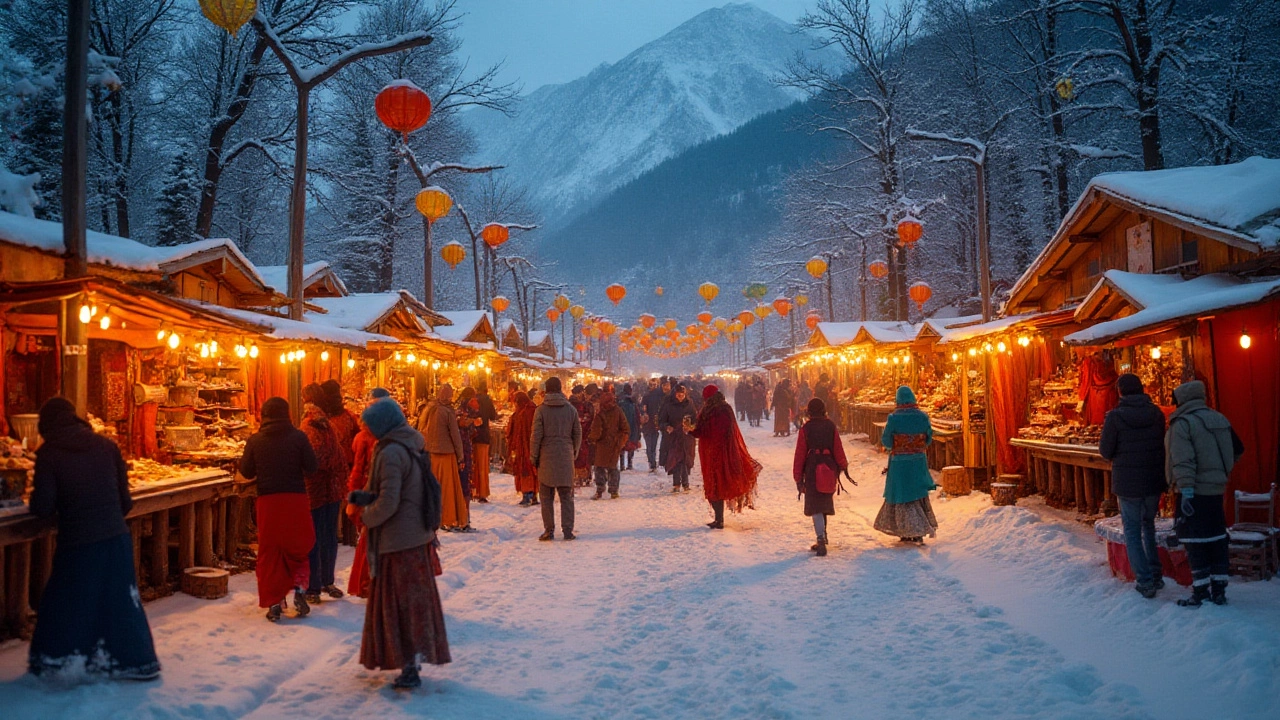
Cultural Festivals
Northern India becomes a vibrant tapestry of colors and sounds during the winter months, as it hosts a myriad of cultural festivals that attract tourists from all over the globe. These festivals not only provide a rollicking good time but also offer a glimpse into the rich historical and cultural tapestry of this fascinating region. One of the most celebrated festivals is Lohri, which marks the end of winter and is celebrated with much fanfare, especially in the states of Punjab and Haryana. People gather around bonfires, throwing foods such as popcorn, puffed rice, and sweets into the flames as they pray for prosperity.
During this festive time, visitors can experience the famous Kumbh Mela which draws millions of pilgrims to the confluence of the Ganges, Yamuna, and the mythical Saraswati rivers. This festival has been declared an Intangible Cultural Heritage by UNESCO, highlighting its significance. The spectacle of sadhus in their saffron robes and the rhythmic chants of holy verses create an aura of spirituality that envelops the entire region. The Kumbh Mela is not just a religious event but a cultural phenomenon that provides insights into the life and spirituality of Hindus.
"The Kumbh Mela is considered the world's largest gathering of people for a religious event, demonstrating the powerful pull of faith," notes a renowned travel journalist.
Not to be missed is the Jaipur Literature Festival, celebrated in the Pink City, which is a paradise for literature enthusiasts. Here, people from all walks of life engage in stimulating discussions and debates with famous authors and thinkers. This festival is a fabulous opportunity for those interested in literature and culture to be part of something intellectually enriching. Equally fascinating is the Rann Utsav in Gujarat, albeit slightly afar from the core of Northern India, where the endless stretch of salt desert comes alive with cultural programs and festivities. It is a celebration of life, accompanied by traditional folk music and dance on chilly desert nights.
The electrifying Vasant Panchami festival marks the arrival of spring and is another noteworthy event. Celebrated with great enthusiasm, it’s dedicated to Saraswati, the goddess of knowledge and wisdom. People dress in yellow, prepare traditional dishes, and engage in kite flying. Such festivals during the winter season not only bridge communities but also offer a chance to indulge in the unique and varied cuisines of Northern India, from spicy street foods to gourmet delights. Overall, the cultural festivals offer an exciting and immersive way to experience the diverse traditions of Northern India, ensuring that every journey during this chilly season is as enriching as it is joyous.
Travel Tips
Traveling to Northern India in the winter requires a fresh set of considerations and careful planning, as the climate can be quite cold, especially in mountainous regions. It's important to be well-prepared for the varying weather conditions. The region encompasses everything from the snowy peaks of Himachal Pradesh and Uttarakhand to the chilly yet dry plains of Delhi and Punjab. Keeping this diverse geography in mind, travelers should pay attention to clothing. Layering is the key to staying warm and comfortable. Start with thermal wear as a base, add sweaters or fleeces, and top it with a windproof, waterproof jacket. Don’t forget woolen caps, scarves, and gloves which are indispensable items in any winter travel kit in North India.
Transportation is another critical aspect worth noting, as winter conditions may impact travel plans. Roads can become treacherous in snowy conditions, especially in hilly areas like Shimla and Manali, where landslides and roadblocks might occur. Thus, checking weather forecasts and road conditions regularly is prudent. Tourists may find trains a reliable choice, offering a more constant schedule compared to road travel. The Indian Railways network connects many important towns and cities, providing an excellent way to traverse long distances with comfort and scenic views. It’s also noteworthy that low visibility due to fog can disrupt travel schedules, so allowing extra time in your itinerary for possible delays is wise.
Accommodation can significantly enhance your travel experience, and booking in advance allows you to get the best places at competitive rates. Many visitors prefer staying in lodges or hotels offering a boutique feel with a warming fireplace or in some cases, facilities like a heated pool. These accommodations often provide insights into local flora and fauna and include guided tours into the surrounding areas. For adventure lovers, options like camping in the snow can be explored, but ensure that you're opting for services from reputed agencies that provide proper heating arrangements. Always remember to carry gear suitable for sub-zero conditions if venturing into higher altitudes.
One cannot ignore the cultural richness that can be experienced during this time of year. Participating in local festivals such as Lohri in Punjab or Makar Sankranti in Uttar Pradesh provides a glimpse into the vibrant traditions of the region. Seasonal gatherings often include dance, music, and hospitality unparalleled in warmth. As famed naturalist Sir David Attenborough once noted,
"India intrigues, fascinates, and thrills and nowhere more so than in its ability to turn the bleak of winter into something extraordinary." The immersive experience of these rituals and events adds a profound layer of enjoyment to the winter travel expeditions.
A special tip for culinary enthusiasts: make sure to indulge in the local winter cuisine, which adapts beautifully to the cold with its warmth and spice. Meals become more robust with dishes like Makki di Roti and Sarson da Saag. The local marts also bristle with stalls selling a variety of snacks, teas, and sweets that bring fiery warmth to the frostiest of days. Tea tasting tours in Kangra can also offer an exceptional way to warm up and appreciate local craftsmanship. For those looking to learn and recreate these flavors, cooking classes are offered by several hotels and local families, making sure you bring a taste of India back home.
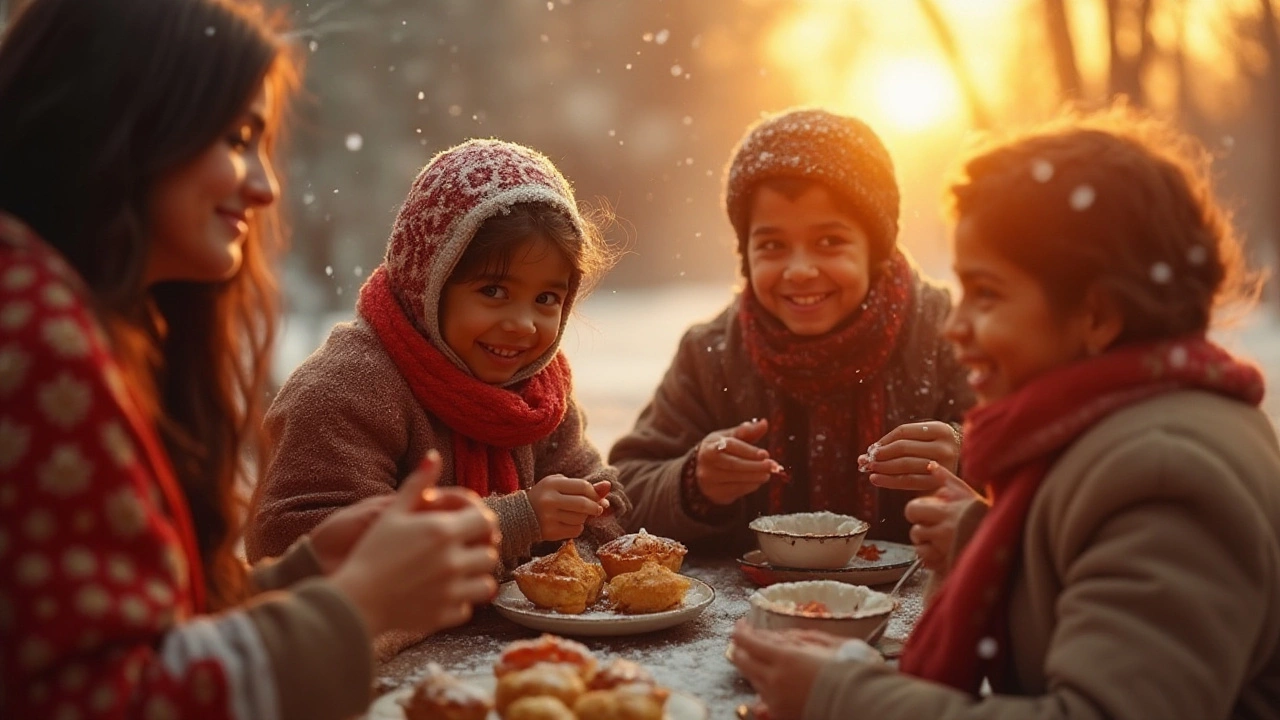
Winter Cuisine
As the air becomes cooler, the kitchens across Northern India buzz with the creation of dishes that are as heartwarming as the region’s winter landscapes. The colder months herald the arrival of rich, flavorful recipes that are traditionally prepared to provide warmth and nourishment. Spices play a crucial role in these dishes, not only enhancing flavors but also providing the body with the heat required during the chilly season. Ingredients such as ginger, garlic, black pepper, and cinnamon are used generously, and each adds its own aromatic essence. It's fascinating how different regions infuse local flavors to create variants that, while sharing a common base, carry unique identities.
One can hardly speak of India winter travel without mentioning some quintessential dishes like "Sarson Ka Saag and Makki Ki Roti" which are staples in Punjab. The mustard greens are cooked slowly to release their earthy flavor, blended with spices, and paired with corn flour flatbread to create a comforting meal. In the soul-warming streets of Delhi, "Chole Bhature" is the perfect combination of spicy chickpeas and deep-fried bread, often accompanied by pickles and onions, making it a favorite street food choice. Towards the Himalayan region, "Thukpa," a noodle soup, is popular, borrowing elements from Tibetan cuisine and offering a hearty bowl filled with vegetables, meat, and a gentle touch of spices.
Another flavorful delight includes the Kashmiri delicacy "Rogan Josh," a robust curry characterized by the use of spices like fennel, ginger, and asafoetida, along with Kashmiri chilies that lend a vibrant color. Prominent regardless of the season, "Kahwah" continues as a favored traditional green tea consumed copiously during the cold months, warming the heart and soul alike. According to Julia Tse, author of 'The Subcontinent's Spice',
"The vibrant tapestry of Northern India's cuisine is nowhere more beautifully expressed than in its winter feasts, serving as a mirror to the diversity of the region."Sweet lovers indulge in "Gajar Ka Halwa," a carrot-based dessert infused with cardamom and garnished with nuts. It's a seasonal favorite not only for its sweet flavor but also the warmth and energy it provides.
To truly delve into the Northern India weather experience, one must understand the complexities and splendors of its winter cuisine. It magnifies the sense of community, as meals are often shared surrounded by family and friends. In some communities, special winter foods are crafted, often shared during intimate gatherings by a bonfire, harmonizing perfectly with the cold ambiance outside. This culinary journey reaffirms the idea that food in Northern India not only satiates hunger but also embodies warmth, hospitality, and the intricate cultural legacy of the land. With each dish narrating a story, visitors can savor not just the taste but also a glimpse of the rich heritage intertwined with the preparation and consumption of these meals.
